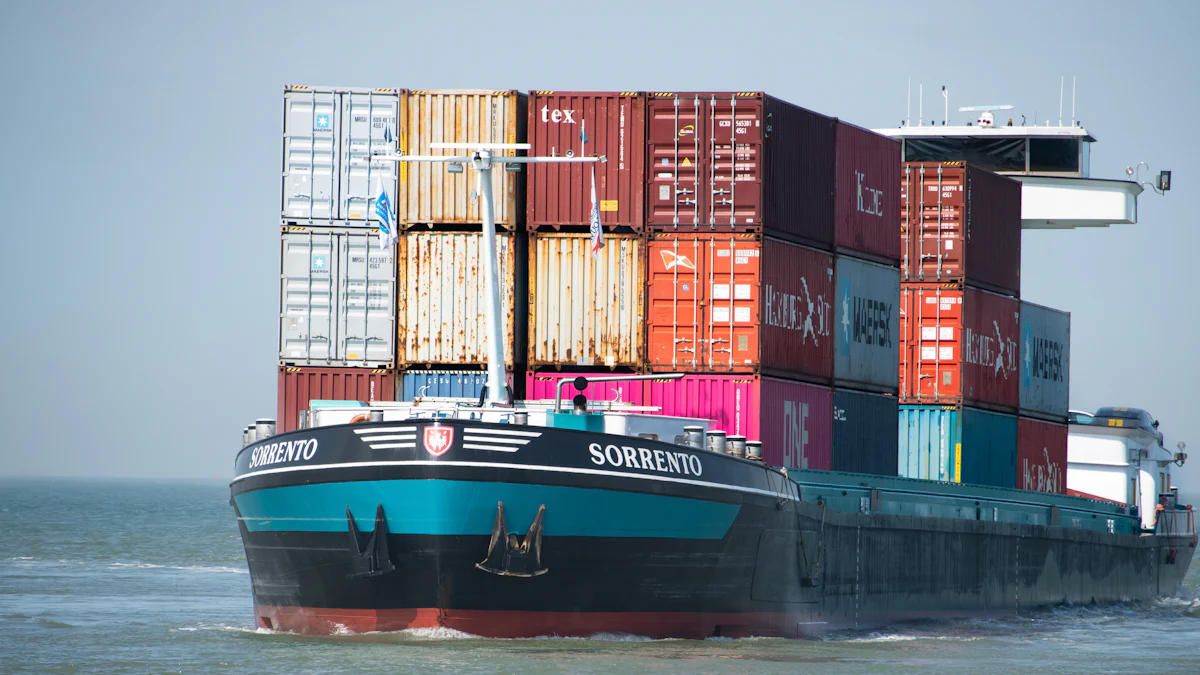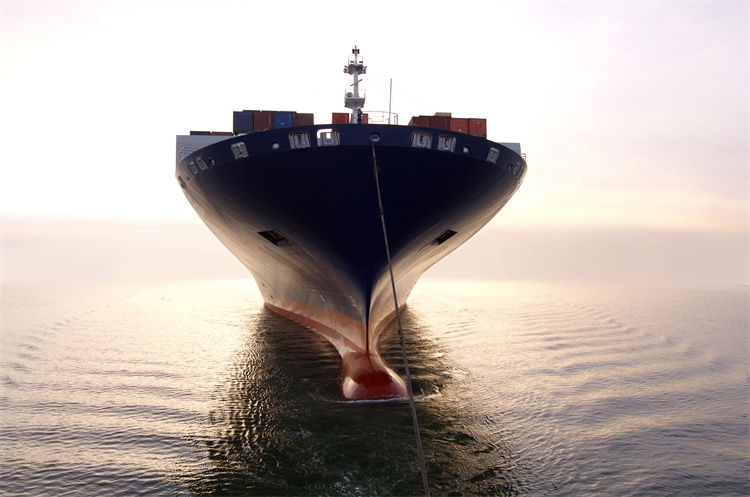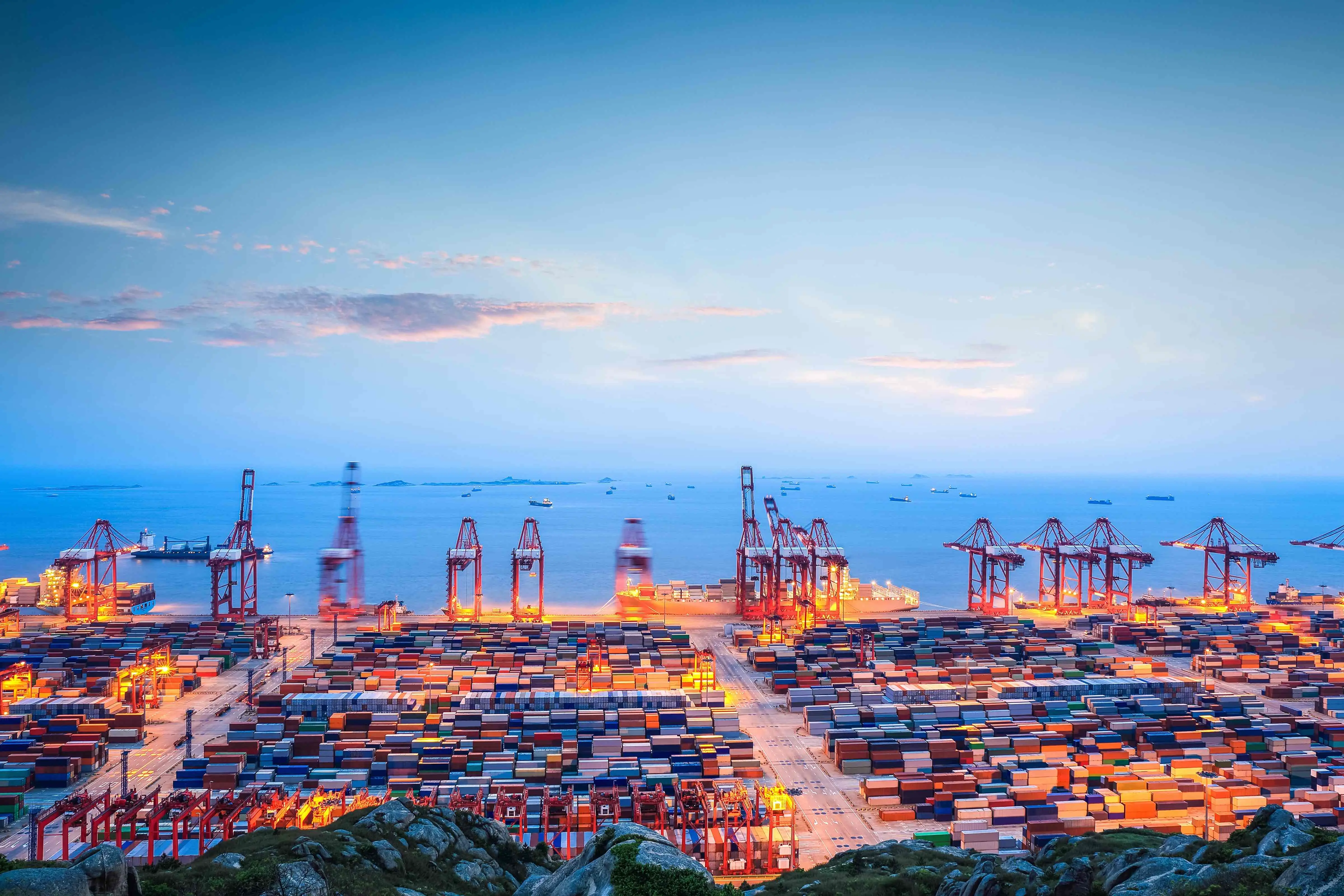How Ocean Shipping Works in 2025

Ocean shipping in 2025 has transformed into a highly efficient and sustainable industry. Automation, such as AI and IoT, optimizes routes and operations. Digital platforms enhance customer service with advanced analytics. Freight forwarders, managing over 80% of global trade, ensure seamless cargo movement. Sustainability efforts include alternative fuels like methanol and ammonia.
Key Takeaways
Use automation and digital tools to make shipping faster. AI and IoT help plan routes and track cargo better.
Focus on eco-friendly fuels and energy-saving tech. This cuts pollution and meets global rules.
Work with freight forwarders for easy shipping management. They handle papers, customs, and cargo tracking.
Ocean Shipping in 2025
Key Developments and Trends
Ocean shipping in 2025 has embraced cutting-edge technologies to enhance efficiency and sustainability. You now see the widespread use of advanced data analytics, AI, and IoT devices to optimize routes and operations. Automated ports and smart warehouses have significantly reduced turnaround times, making the shipping process faster and more reliable. Blockchain technology has improved transparency and security, while IoT sensors provide real-time updates on cargo conditions. Autonomous ships, equipped with AI, minimize human error and optimize fuel consumption.
Sustainability remains a top priority. The International Maritime Organization (IMO) has set ambitious goals, including net-zero greenhouse gas emissions by 2050. To meet these targets, companies are adopting alternative fuels like LNG, hydrogen, and ammonia. New ship designs and energy-efficient engines further reduce emissions. Retrofitting older vessels with green technologies ensures that even existing fleets contribute to a cleaner environment.
Role of Freight Forwarders in Modern Shipping
Freight forwarders play a vital role in modern ocean shipping. They act as agents in the logistics network, ensuring smooth cargo movement. You rely on them for freight consolidation, rate negotiation, and shipment tracking. They also handle customs clearance and documentation, which simplifies the shipping process for you. Many freight forwarders offer end-to-end solutions, including warehousing and cargo insurance. Their expertise in niche areas, such as rail-freight integration, adds value to global trade operations.
JUSDA’s Contribution to Ocean Shipping
JUSDA has revolutionized ocean shipping with its innovative solutions. Its Supply Chain Management Collaboration Platform integrates AI, IoT, and blockchain to streamline operations. You benefit from real-time tracking, demand forecasting, and efficient transport coordination. JUSDA’s JusLink platform enhances transparency and collaboration across the supply chain. By adopting green shipping practices and optimizing logistics, JUSDA helps you achieve cost-effective and sustainable global trade.
Step-by-Step Process of Ocean Shipping
Cargo Preparation and Documentation
Preparing cargo is the first step in ocean shipping. You must ensure the goods are packaged securely to withstand the rigors of transportation. Proper labeling is essential to identify the cargo and its destination accurately. Documentation plays a critical role in this stage. You need to comply with international regulations by preparing documents like the commercial invoice, packing list, and bill of lading. These steps ensure your shipment is ready for smooth transit and customs clearance.
Tip: Double-check your documentation to avoid delays or fines during customs processing.
Freight Forwarding and Booking
Freight forwarding simplifies the logistics of ocean shipping. Freight forwarders help you book space on vessels, negotiate rates, and manage shipment tracking. However, challenges like fluctuating shipping rates and unexpected delays can arise. You may also face customs clearance issues due to varying regulations across countries. To overcome these, you need proactive communication and enhanced visibility into your shipments. Freight forwarders often use digital platforms to provide real-time updates, helping you manage delays and meet customer expectations.
Loading, Transit, and Port Operations
Once your cargo is ready, it moves to the port for loading. Key operations include:
Mooring and Unmooring: Securing the vessel at the dock and preparing it for departure.
Cargo Handling: Loading and unloading goods efficiently to minimize delays.
Pilotage: Expert navigation within port waters to ensure safety.
During transit, IoT sensors monitor your cargo's condition, providing real-time updates. At the destination port, similar operations ensure your shipment is unloaded and prepared for the next stage.
Customs Clearance and Final Delivery
Customs clearance is a crucial step. You must gather all required documents, calculate duties and taxes, and submit them to customs. Using a licensed customs broker can simplify this process. Once customs approves your shipment, it moves to the final delivery stage. Freight forwarders coordinate with local transport providers to ensure your goods reach their destination on time.
Note: Efficient customs clearance reduces delays and ensures a smooth delivery process.
Innovations Shaping Ocean Shipping

Automation and Digital Platforms
Automation and digital platforms have transformed how you approach ocean shipping. These innovations streamline operations and improve efficiency. Key advancements include:
Blockchain Technology: Enhances transparency and security with real-time tracking and smart contracts.
Internet of Things (IoT): Provides real-time data on cargo conditions, helping you monitor shipments effectively.
Autonomous Ships: Navigate without human intervention, reducing errors and operational costs.
Artificial Intelligence (AI): Optimizes routes by analyzing weather and traffic data, ensuring timely deliveries.
Smart Containers: Equipped with sensors, these containers monitor cargo conditions, ensuring quality during transit.
These technologies allow you to manage resources better, reduce risks, and improve decision-making.
Real-Time Tracking and JusLink Integration
Real-time tracking has become a cornerstone of efficient shipping operations. Platforms like JUSDA’s JusLink provide you with unparalleled visibility into your supply chain. Here’s how real-time tracking benefits you:
Benefit | Description |
|---|---|
Receive real-time information to anticipate disruptions. | |
Proactive Problem-Solving | Respond quickly to issues like port congestion or adverse weather. |
Better Route Management | Adjust routes efficiently, ensuring smoother operations. |
JusLink integrates IoT and big data to give you actionable insights. This integration ensures you stay informed and maintain control over your shipments.
Tip: Use platforms like JusLink to enhance collaboration and minimize delays.
Sustainability and Green Shipping Practices
Sustainability has become a priority in ocean shipping. Companies now adopt green practices to reduce environmental impact. These include:
Using alternative fuels like methanol, ammonia, and hydrogen to cut carbon emissions.
Implementing energy-efficient technologies such as wind-assisted propulsion and battery-hybrid engines.
Increasing the use of Environmentally Acceptable Lubricants (EALs) to reduce marine pollution.
By embracing these practices, you contribute to a cleaner and more sustainable future.
Note: Sustainable shipping practices not only protect the environment but also align with global regulatory standards.
Cost and Efficiency in Ocean Shipping
Factors Influencing Shipping Costs
Several factors determine the cost of ocean shipping in 2025. Understanding these can help you plan better and manage expenses effectively:
Fuel Prices: Fluctuations in oil prices directly impact bunker fuel costs, which significantly affect freight rates.
Port Fees: Docking, handling, and storage charges vary by port, influencing overall costs.
Surcharges: Additional fees like the Bunker Adjustment Factor and Emergency Risk Surcharge can increase expenses.
Currency Exchange Rates: Changes in exchange rates affect route competitiveness and total costs.
Demand and Supply Dynamics: Rates rise during peak seasons and drop when demand is low.
Environmental Regulations: Compliance with stricter emission standards raises operational costs.
Geopolitical and Economic Factors: Global events and trade policies can lead to rerouted lanes and higher security costs.
Insurance: The type of goods you ship determines insurance costs, adding to your expenses.
Container Handling and Haulage: Moving containers efficiently is a significant cost factor.
By analyzing these elements, you can better anticipate and control shipping expenses.
JUSDA’s Approach to Cost Optimization
JUSDA employs advanced strategies to optimize costs in ocean shipping. Its Supply Chain Management Collaboration Platform uses AI and big data to streamline operations. You benefit from tools like demand forecasting and transport coordination, which reduce inefficiencies. JUSDA also consolidates shipments to maximize container loads, lowering expenses. By integrating real-time tracking through JusLink, you gain visibility into your supply chain, enabling proactive decision-making. These innovations ensure you achieve cost-effective shipping without compromising quality or reliability.
Balancing Cost, Speed, and Reliability
Balancing these three factors requires strategic planning. You can prioritize speed for products with short life cycles to meet market demand. For urgent shipments, airfreight may be a better option. Customizing your modal mix allows you to find the right balance between cost and speed. Consolidating shipments and negotiating contracts can further reduce expenses. JUSDA’s technology-driven solutions help you optimize inventory management and shipping processes. By leveraging these strategies, you can maintain reliability while keeping costs under control.
Tip: Use digital platforms to analyze shipping options and choose the best fit for your needs.
Environmental Impact and Sustainability

Challenges of Emissions and Pollution
Ocean shipping faces significant environmental challenges. Carbon dioxide emissions from ships contribute to air pollution and alter ocean chemistry, increasing acidity and threatening marine ecosystems. Nitrogen oxide emissions create ground-level ozone, which can cause respiratory issues for people living near busy ports. Noise pollution from vessels disrupts marine species that rely on sound for communication and navigation. Additionally, discharges like ballast water and sewage introduce harmful organisms and pollutants into the ocean, further damaging marine habitats. Addressing these challenges is essential to protect both the environment and public health.
Eco-Friendly Practices in 2025
The maritime industry has adopted innovative practices to reduce its environmental footprint. Advances in ship design, such as hydrodynamic hull forms and air lubrication systems, have significantly lowered fuel consumption and emissions. Many companies now use alternative fuels like methanol, ammonia, and hydrogen, which produce fewer carbon emissions than traditional fuels. Technologies like wind-assisted propulsion systems, battery-hybrid engines, and waste heat recovery systems also play a crucial role in cutting emissions and improving energy efficiency. These practices demonstrate the industry's commitment to sustainability and environmental stewardship.
Regulatory Standards and Industry Compliance
Strict regulations ensure that ocean shipping aligns with global environmental goals. For example, the FuelEU Maritime regulation, effective January 1, 2025, requires ships over 5,000 gross tonnage to meet greenhouse gas intensity limits. The EU Emissions Trading System mandates emissions monitoring and reporting, with trading obligations for intra-EU voyages starting in 2025. By 2029, 100% of emissions from voyages to and from EU ports will fall under this system. These standards drive the industry toward cleaner and more sustainable operations.
Regulation | Effective Date | Key Requirements |
|---|---|---|
FuelEU Maritime | January 1, 2025 | Ships over 5,000 gross tonnage must comply with GHG intensity limits, progressively stricter over time. |
EU Emissions Trading System | January 1, 2024 | Monitoring and reporting of emissions begins; trading obligations for intra-EU voyages start. |
January 1, 2025 | Emissions trading obligations for intra-EU voyages commence. | |
January 1, 2027 | Obligations extend to 50% of emissions from voyages starting or ending outside the EEA. | |
January 1, 2029 | 100% of emissions from all voyages to/from EU ports are covered. |
Tip: Staying informed about regulatory changes helps you ensure compliance and avoid penalties.
Comparing Ocean Shipping to Other Modes
Ocean Shipping vs. Air Freight
Ocean shipping offers several advantages over air freight, especially when you consider cost and environmental impact:
Ships produce significantly lower carbon emissions per ton-mile than airplanes, making sea freight a greener choice.
Airfreight generates 47 times more greenhouse gases than ocean shipping for every ton-mile.
Ocean liners have a smaller carbon footprint per load compared to planes, which emit gases directly into the upper atmosphere.
Sea freight provides more capacity and value. For example, a single container can hold up to 10,000 beer bottles, which is far more than what airfreight can handle.
While air freight is faster, ocean shipping remains the better option for large, non-urgent shipments that prioritize cost and sustainability.
Ocean Shipping vs. Rail and Road Transport
Ocean shipping, rail freight, and road freight each have unique strengths. Here’s how they compare:
Transport Mode | Efficiency | Scalability |
|---|---|---|
Ocean Shipping | Cost-effective for bulk transport; lower carbon footprint | High capacity for large volumes |
Rail Freight | Fuel efficient for heavy cargo; extensive infrastructure | Efficient for high volumes on popular routes |
Road Freight | Fast and flexible; true point-to-point service | Economical for short hauls and smaller loads |
Ocean shipping excels in moving large volumes of goods across long distances, especially internationally. Rail and road transport are better suited for regional or domestic logistics.
When Ocean Shipping is the Best Choice
You should choose ocean shipping under these circumstances:
When transporting bulk commodities like grains, crude oil, or raw materials that don’t require fast delivery.
For large shipments, as the cost per unit decreases with volume.
When prioritizing sustainability, since ocean freight has a lower environmental impact than air freight.
For bulky or heavy cargo, as containers can hold significant volumes.
When shipping internationally across oceans, as it provides a reliable and economical solution.
Ocean shipping is ideal for cost-conscious businesses that value capacity and sustainability over speed.

JUSDA Solutions
To provide you with professional solutions and quotations.
Ocean shipping in 2025 thrives on innovation, efficiency, and sustainability. You benefit from advancements like alternative fuels, energy-efficient technologies, and AI-driven solutions. JUSDA empowers you to navigate global trade complexities with digital tools and strategic partnerships. Choosing the right transport mode depends on balancing cost, speed, and environmental priorities for your business success.
See Also
Discovering 2024 Innovations in Sea Freight Logistics
Get Prepared: Unveiling New Transport Tech for Supply Chains
An In-Depth Look at LTL Freight's Future
